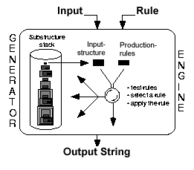Dynamically generated text is necessary for many intelligent applications that provide information or include a need to communicate. Many of these applications - for instance, stock market reports, wheather reports, appointment scheduling dialogues - are characterized by stereotypical formulations instantiating only a limited set of parameters. For instance, in appointment scheduling negotiations, suggestion, acceptance, rejection or counter-suggestion of a date are the basic speech acts. For environmental air quality reports, condensed descriptions of time series and of exceeding threshold values are most important.
These applications allow for a complete a-priori structuring of the texts to be generated, which renders it possible to dispense with complex text planning and inference tasks that usually form a prerequisite for generating high-quality, readable text. It is perfectly adequate to address the problem with a more handsome approach.
It is for this kind of application that TG/2 offers a commercially viable solution. TG/2 can deal with different kinds of input representations.. Flat input, such as a list of domain-specific attribute-value pairs, can be accomodated as well as complex structured logical form representations of sentential semantics.
TG/2 stands for a flexible generation of template-based generators. The system is organized as a classical production system, separating the generation rules from their interpreter. Generation rules are defined as condition-action pairs. They can represent not only templates but also context-free grammar rules, using category symbols. Integrating these rule types into a single formalism allows for a shallow modelling of language where this proves sufficient, or for more fine-grained models whenever necessary. The interpreter consists of the standard three-step processing cycle:
- determine the set of applicable rules,
- select one from this set, and
- execute it.
By simultaneously designing rule systems for multiple languages, one gets multilingual generation almost for free. Developing a rule system for an additional language costs much less effort than the initial system since associations to input structures can be copied in most cases.
TG/2 is implemented in Allegro Common Lisp and runs on Unix and PC platforms.
- TG/2 offers solutions for limited sublanguages that are tuned towards the domain and the task at hand
- TG/2 can quickly be accommodated to new tasks (average effort approx. three person-months);
- TG/2 can be integrated smoothly with
deepgeneration processes; - TG/2 integrates canned text, templates, and context-free rules into a single formalism;
- TG/2 efficiently reuses generated substrings for alternative formulations;
- TG/2 can be parameterized to produce the preferred formulation first (regarding style, grammar, fine-grained rhetorics etc.).

